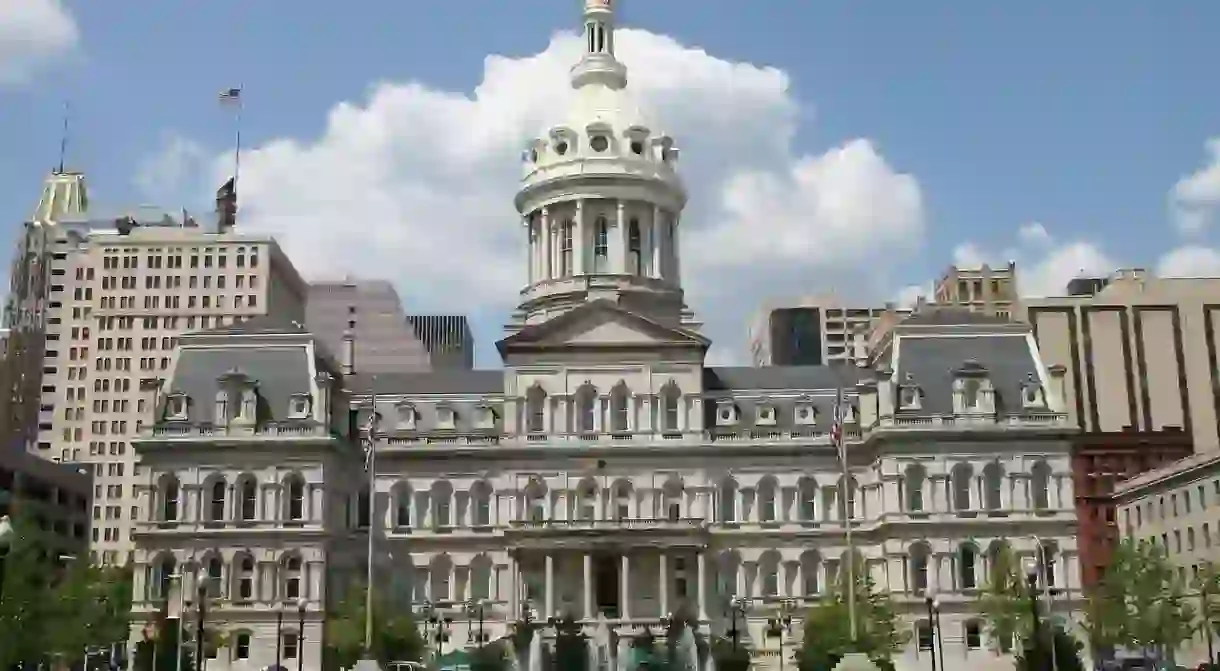The Perfect Walking Guide to Baltimore, MD

Baltimore’s layout, distinct neighborhoods, and waterfront make it a fairly walkable city. But if you want the highlights of the coolest places to get to on foot, check out this perfect walking guide to the city’s historical landmarks, shopping centers, and more.
A. Washington Monument
Start at Washington Place in central Mount Vernon, where the Washington Monument towers over all. Baltimore’s Washington Monument, at 178 feet (54 meters) tall, was made before its more famous cousin in nearby Washington D.C., built in 1815 to honor George Washington’s death. On certain days, you can climb up the 227 steps for a picturesque view.

B. Mount Vernon Place United Methodist Church
Right across the traffic circle is the striking 1872 Norman-Gothic “Cathedral of Methodism.” The Mount Vernon Place United Methodist Church is considered the most significant architectural landmark in the city of Baltimore by the American Institute of Architects, and for good reason. Admire its towers and flying buttresses, its use of green serpentine fieldstone, and its interior iron columns and stained glass.

C. Walters Art Museum
Walking to the southern end of Washington Place, you’ll find the Walters Art Museum, a free public art museum. The art institution, founded in 1934, features works from various cultures and periods, including Greco-Roman, Ancient Egyptian, Art Deco, and Middle Eastern. Alongside the collection, the museum also features special exhibitions and events.

D. Enoch Pratt Free Library
Next, walk toward Cathedral Street to the Enoch Pratt Free Library, whose central branch takes up an entire block between Franklin and Mulberry Streets. The Enoch Pratt Free Library System is one of the oldest public libraries in the country, established in 1882. The main building, completed in 1933, features beautiful murals, decorative moldings, and ceiling art.

E. Basilica of the National Shrine of the Assumption of the Blessed Virgin Mary
Across the street, you’ll find America’s first cathedral, the Baltimore Basilica. Designed by “Father of American Architecture” Benjamin Henry Latrobe and opened in 1821 (though not completed until 1863), the Basilica is a neoclassical, domed masterpiece, visited by Catholics and admirers from around the world. The cathedral also has a garden around the back by N. Charles and Franklin Streets, the Pope John Paul II Prayer Garden.

F. Lexington Market
The next stop, for food and history, is the “World Famous” Lexington Market, the oldest public market in the United States. First opened in 1782, Lexington Market currently hosts 93 local vendors selling everything from seafood to soul food, cosmetics to computers, and more. Pick up some chicken and waffles, Berger Cookies®, or whatever you fancy before moving on to the next stop on the walking tour.

G. Westminster Hall & Burying Grounds
Once a Presbyterian church, Westminster Hall still maintains its burying grounds, which host the remains of many famous early Marylanders, including U.S. Congress members and community benefactors who were the namesakes for Baltimore landmarks. But most notably, you’ll find the grave of Gothic poet and novelist Edgar Allan Poe, both his original burial spot and permanent grave, as well as those of his family members. Look out for tributes left at his grave by fellow admirers.

H. City Hall & War Memorial
Walking down Fayette Street, you’ll find Baltimore’s City Hall, a six-story French Revival structure. The founding of the City Hall in 1875 helped to establish Baltimore as an important American city and is still the seat of city government to this day. The nearby War Memorial building is a meeting place and memorial for Maryland veterans, with prominent horse sculptures at the entrance.

I. Inner Harbor
Heading toward the Phoenix Shot Tower, then past the Port Discovery Children’s Museum on Market Place and toward the water, you’ll see the Inner Harbor, full of attractions for all ages. Make your way around the harbor to check out the historic ships, explore the museums like the National Aquarium and Maryland Science Center, and go to the Top of the World Observation Deck at the World Trade Center for a bird’s-eye view.

J. Federal Hill
End your walk in the Federal Hill Historic District. Just south of the Inner Harbor and one of the coolest neighborhoods in Baltimore, the cobbled streets are packed with creative shops, markets, and restaurants. It’s most known for its 10-acre park, with a great hill used historically to spot merchant ships from overseas and approaching enemies during wartime. Today, the view is used recreationally for iconic views of the harbor, but the park still features cannons left as monuments to its past.














